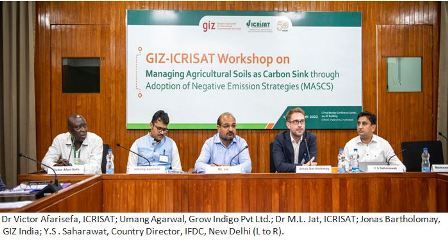Soil Carbon Sequestration Can Help Fight Climate Change
Carbon sequestration is the process of capturing and storing atmospheric carbon dioxide.
Food systems account for nearly one-third of greenhouse gas emissions. In 2015, food-system emissions amounted to 18 Gt CO2 equivalent per year globally, representing 34% of total GHG emissions. ICRISAT (International Crops Research Institute for The Semi-Arid Tropics)has published a modelling study that revealed how the right combination of fertilizer, biochar, and irrigation could potentially increase soil carbon by as much as 300% and help mitigate climate change.
emissions amounted to 18 Gt CO2 equivalent per year globally, representing 34% of total GHG emissions. ICRISAT (International Crops Research Institute for The Semi-Arid Tropics)has published a modelling study that revealed how the right combination of fertilizer, biochar, and irrigation could potentially increase soil carbon by as much as 300% and help mitigate climate change.
The modelling study was conducted in five districts of Maharashtra (Jalna, Dhule, Ahmednagar, Amravati, and Yavatmal) and eight districts of Odisha (Angul, Bolangir, Deogarh, Dhenkenal, Kalahandi, Kendujhar, Nuapada, and Sundegarh). They have a predominantly semi-arid climate with annual rainfall between 600 mm and 1,100 mm. This soil carbon sequestration over 30 years in these 13 districts may significantly contribute to combating global climate change.
Carbon sequestration is the process of capturing and storing atmospheric carbon dioxide. ICRISAT scientists, during 2020-2022, collected various data such as weather, soil types, crop yield, and crop management practices. They made projections for carbon sequestration and yields and conducted long-term experiments based on such data.
The researchers also evaluated improved management practices such as biochar, need-based fertilizer, and irrigation. Biochar is a charcoal-like substance that burns organic material (biomass) from agricultural and forestry wastes in a controlled process called pyrolysis. Although it looks much like ordinary charcoal, biochar has safely reduced contamination and stored carbon.
The modelling study found that biochar increased carbon value in the soil by 130-300% over 30 years with little difference in yield. It also found that the optimal use of fertilizers increased the carbon and output by up to 30%. The carbon sequestration increased by more than 300% in combination with fertilizer, biochar, and irrigation. The study is aligned with Sustainable Development Goal 13 (SDG 13: Climate Action), which is on taking urgent action to combat climate change and its impacts.
Important crops such as cotton, sorghum, soybean, chickpea, pigeon pea and millet were studied in the region. In addition, soil sampling and analysis of long-term experiments on improved versus traditional farmer practices and tillage and residue management practices were also conducted.
Scientists observed a significant increase in soil carbon with improved nutrients, crop/variety, landform, minimum tillage and residue addition under the climate change scenario till 2100.
Soil carbon is critical for crop yield and climate adaptation or mitigation measures which are heavily reduced by both intensive agriculture and indiscriminate use of chemicals leading to increased carbon emissions.
“Profile sampling of long-term experiments found that carbon sequestration increased by 100 kg ha per year with the improved practices of landform management, fertilizers and crop varieties over 45 years. It is enhanced by 300 kg ha per year with residue over nine years (Aditi et al. 2021),” said Dr Girish Chander, co-lead of the project, which studied carbon sequestration.
The German Agency for International Cooperation (GIZ) funded the research. “We would like to analyse how carbon behaves under different agricultural practices,” says Jonas Bartholomay, Program Director, GIZ India.
“Agriculture is said to be one of the major factors affecting climate change. However, it can also be a part of the solution. Carbon sequestering can provide an additional source of income for the farmers,” he said.
The study may help policymakers, government, and civil society implements strategies that incentivize farmers to manage their soils to sequester more carbon.
A new gaming app, ‘Mrida’, has been launched to promote behavioural change among farmers. Dr Melesse Mequanint, co-lead (economics, game app and capacity building), said, “Apart from English, the app will be released in Marathi and Odiya to reach a larger population of farmers in the two states.”
